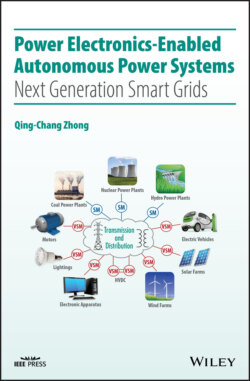Читать книгу Power Electronics-Enabled Autonomous Power Systems - Qing-Chang Zhong - Страница 37
2.6 Brief Description of Technical Routes 2.6.1 The First‐Generation (1G) VSM
ОглавлениеDifferent options to implement VSMs are available in the literature. The VISMA approach (Beck and Hesse 2007; Chen et al. 2011) controls the inverter current to follow the current reference generated according to the mathematical model of synchronous machines, which makes inverters behave like controlled current sources. Since power systems are dominated by voltage sources, this may bring detrimental impact, in particular on system stability (Dong et al. 2013; Sun 2011; Wen et al. 2015). The approach proposed in (Gao and Iravani 2008) follows the mathematical model of SMs but it requires the measurement of the grid frequency, which is often problematic in practice (Dong et al. 2015). The approach proposed in (Karimi‐Ghartemani 2015) controls the voltage but it also requires the measurement of the grid frequency for the real power frequency droop control. The synchronverter approach (Zhong and Weiss 2009, 2011; Zhong et al. 2014) directly embeds the mathematical model of synchronous machines into the controller to control the voltage generated, even without the need for measuring the grid frequency or a phase‐locked loop (Zhong et al. 2014). The synchronverter has been further developed for microgrids (Ashabani and Mohamed 2012), HVDC applications (Aouini et al. 2016; Dong et al. 2016), STATCOM (Nguyen et al. 2012), PV inverters (Ming and Zhong 2014), wind power (Zhong et al. 2015), motor drives (Zhong 2013a), and rectifiers (Ma et al. 2012; Zhong et al. 2012b). The synchronverter technology offers a promising technical route to implement SYNDEM smart grids and is described in detail in Part II. Because it offers a basic and conceptual implementation of VSMs, it is classified as the first‐generation (1G) VSM.
